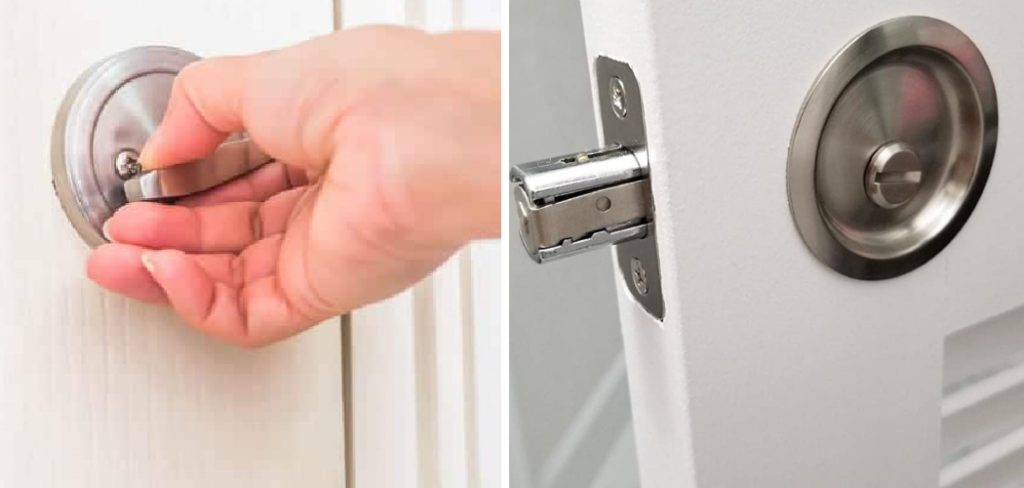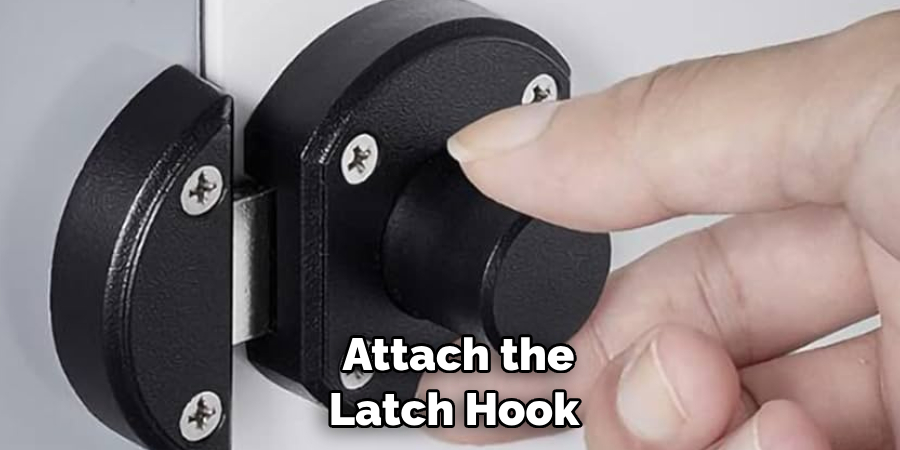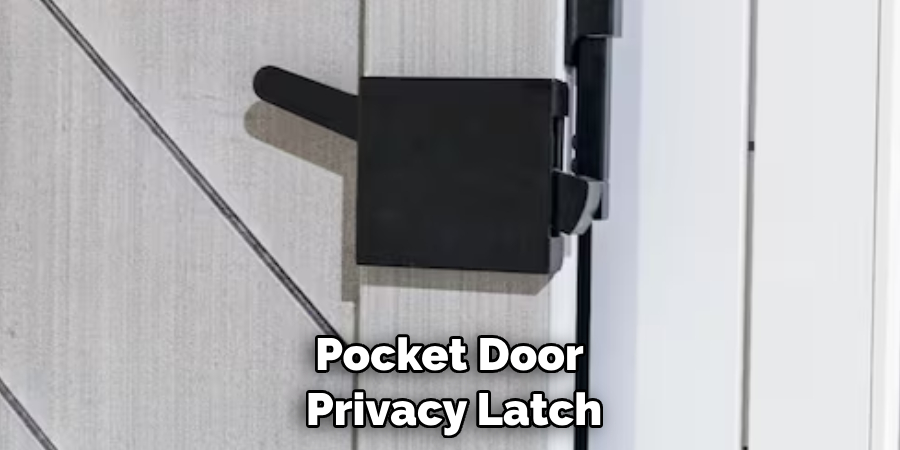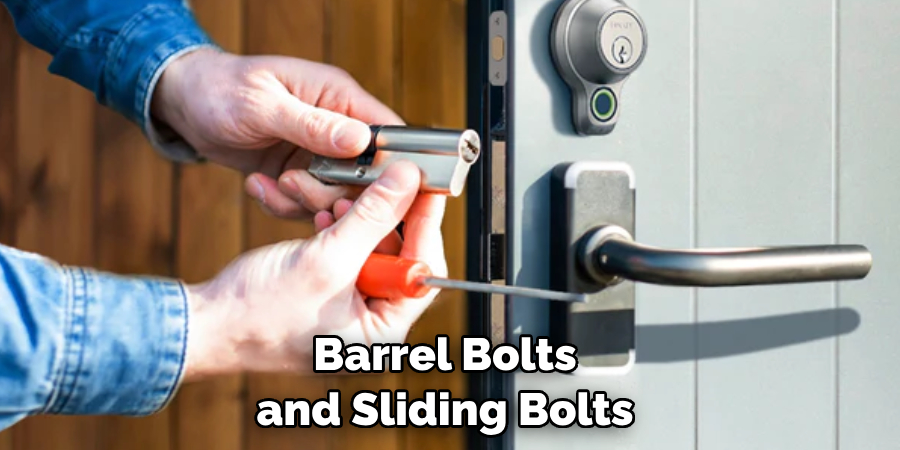Do you have a pocket door that has become an inconvenience since it won’t stay shut without a lock? Would you like to know how to prevent the frustration of having your door swing open when you don’t want it to? Trying to find ways to keep these doors securely shut without installing an expensive and complicated lock system can be difficult and frustrating.

Thankfully, some easy tips and tricks will show you how to lock a pocket door without needing one! This blog post’ll look at simple solutions for locking your pocket door, from adhesive tape or magnets to retrofitting with locksets.
Keep reading if you’d like to learn more about how to lock a pocket door without a lock!
What Will You Need?
To lock a pocket door without a lock, you will need the following supplies:
- Adhesive tape or sticky pads
- Magnets
- A latch hook
- A screwdriver and screws (depending on which method you choose)
Once you have gathered all of these items, you’ll be ready to start locking your pocket door!
10 Easy Steps on How to Lock a Pocket Door Without a Lock
Step 1. Using Adhesive Tape or Sticky Pads:
The easiest and most cost-effective way to lock a pocket door without a lock is by using adhesive tape or sticky pads. Simply place the tape or sticky pads at the edge of the front of the door and press firmly against the wall. The adhesive will help keep the door shut, but it won’t be as secure as a lock.
Step 2. Install Magnets:
Magnets can also be used to keep your pocket doors securely shut without using a lock. Simply attach one part of the magnet to your door frame and another to your door. When the two pieces of metal attach, they will create a secure seal that prevents your pocket door from opening without a key.
Step 3. Use a Latch Hook:

A latch hook is a small piece of metal with a hook on one end to secure doors in place. To use this method to lock a pocket door without a lock, attach the latch hook to the edge of your door and secure it in place with screws. Once installed, use the hook to lock the door and keep it securely closed.
Step 4. Retrofit With a Lock:
If you want more security than adhesive tape or magnets can provide, consider retrofitting your pocket door with a lockset. This is the most secure way to lock your pocket door, providing maximum security and preventing intruders from entering your home.
The cost of a lockset can vary depending on the type you choose, but they are typically affordable and can be easily installed by following the directions that come with them.
Step 5. Latch String:
A latch string could provide another quick and cost-effective way to lock your pocket door without a lock. To use this method, you must screw in a small hook on both the door and frame. Then, connect the hooks with a string or cord. When you wish to lock the door, just knot the string. While not the most secure option, it will prevent the door from opening casually.
Step 6. Use a Doorstop:

Another method that can be used to lock a pocket door without a lock is using a doorstop. A doorstop can be wedged under the bottom of the door when closed to prevent it from sliding open. This method is less secure than others, but it might serve in a pinch.
Simply find a rubber doorstop that fits the gap between the bottom of your door and the floor. Then, when you want to secure the door, position the doorstop under the door. You can simply remove the doorstop and open it as usual when it’s no longer needed.
Step 7. Use of a Barrel Bolt:
A barrel bolt is another solution to lock your pocket door without a traditional lock. This method, often used on gates, sheds, and bathroom doors, comes with a sliding bolt connected to a spring and fits into a small metal plate. Install the bolt on the interior side of your pocket door and the metal plate on the door frame.
When securing the door, just slide the bolt into the plate. This method offers good security and isn’t too difficult to install. Remember, however, that it should only be used on doors where you won’t need to unlock from the outside.
Step 8. Install a Pocket Door Privacy Latch:

A pocket door privacy latch is a device that’s designed specifically for pocket doors. Unlike a traditional lock, it doesn’t require a key and can be locked or unlocked from either side of the door. This solution is more secure than adhesive tape or a doorstop but less secure than a lockset or barrel bolt.
To use this method, you’ll need to install the latch according to the manufacturer’s instructions, which usually involves screwing it into the door. Once installed, you can simply slide the latch into the closed position to lock the door. Similarly, you slide it into the open position to unlock the door.
Step 9. Use of a Sliding Bolt:
A sliding bolt can also be used to lock a pocket door without a traditional lock. Like a barrel bolt, a sliding bolt is a piece of metal moving from side to side to secure a door. To use this method, you will need to install the sliding bolt on the inside of your door and the corresponding catch on the door frame.
When the door is shut, you can slide the bolt into the catch, effectively locking the door. Remember, this method should only be used on doors that do not require unlocking from the outside.
Step 10. Installation of a Travel Lock:

A travel lock is a portable lock that can secure a pocket door without a standard lock. Easy to install and remove, this device provides security comparable to a traditional lock. You simply need to fit the travel lock into the doorjamb when the door is closed. The design of the travel lock prevents the door from being opened until the device is removed.
This option may be handy for those who rent their property, as it requires no permanent modifications to the door. Just keep in mind, like the sliding bolt and barrel bolt, this method should only be used on doors that do not require unlocking from the outside.
Following these steps, you can keep your pocket door securely closed without a lock. From adhesive tape to travel locks, several cost-effective and secure solutions don’t require the installation of a traditional lock. Just remember to consider each door’s security needs before deciding which option is best for you.
5 Additional Tips and Tricks
- For extra security, consider using multiple methods to lock your pocket door. For instance, a combination of adhesive tape and a sliding bolt can give you added peace of mind.
- If you opt for a lockset or privacy latch, keep track of the keys or pins needed to unlock them in case of emergency.
- If you use a travel lock, ensure the latch is securely fitted into the doorjamb.
- Invest in high-quality materials and hardware to ensure maximum security for your pocket door.
- Regularly check for any potential damage or wear and tear that could compromise the security of your door locks.

With these tips, you can secure your pocket door without needing a lock. Whether you choose to use adhesive tape, a lockset, or any other options discussed above, you can ensure that your home and belongings are safe and secure.
5 Things You Should Avoid
- Avoiding Regular Maintenance: Neglecting regular maintenance of your pocket door and its locking mechanism can lead to gradual wear and tear, reducing its effectiveness over time. Ensure to inspect and maintain your door and its security measures to keep it in optimal working condition.
- Ignoring Privacy Concerns: While some methods of locking a pocket door are convenient, they may not provide adequate privacy. For instance, using a latch string or doorstop may not be suitable for bathrooms or bedrooms where privacy is paramount. Always consider the privacy requirements of the room before choosing a locking method.
- Bypassing Professional Advice: If you’re unsure about installing locking mechanisms yourself, it’s best not to avoid seeking professional advice. Incorrect installation can compromise the security and functionality of your door and potentially cause damage.
- Relying Solely on Makeshift Measures: Makeshift solutions like adhesive tape can be useful in a pinch, but they should be independent of long-term security. Always consider investing in a more robust and permanent solution if the room’s security is a concern.
- Overlooking Emergency Unlocking Needs: While methods like barrel bolts and sliding bolts can provide good security, they can’t be unlocked outside. This could pose a safety concern in case of emergencies. Always consider the location and use of the door before deciding on a locking method.

Avoiding these risks can help you ensure the security of your pocket door without using a traditional lock. With careful planning and consideration, you can choose the best locking solution for your needs and keep your pocket doors secure.
What Type of Door Lock Without a Key?
A combination lock is the most common type of door lock without a key. Combination locks unlock with the use of a code or sequence rather than an actual key. As such, they provide extra security for your home or office by eliminating the need to carry large keys around and providing additional protection against lock picking.
Another option for securing your door without a key is to install a push-button lock. Push button locks require you to press certain buttons to activate the locking mechanism. They are often used for cabinets and drawers but can also be installed on doors if desired.
Finally, biometric door locks are becoming increasingly popular as well. These types of locks unlock with the use of an individual’s fingerprints, making them difficult to bypass and providing an additional level of security.
Using one of these key-free options, you can keep your property secure without needing a traditional lock. Whatever type of lock you choose, ensure it meets your security needs and provides convenience.
Conclusion
Overall, there is a vast range of options when it comes how to lock a pocket door without a lock. Whether it’s through dowels, hook and eye latches, or home-made locks, you now know to stay assured that your pocket door will stay secure without having to purchase a lock.
In terms of safety and security for your satisfaction, apart from simply purchasing a lock for your pocket door, these solutions are also ideal if you’re looking for an inexpensive way of keeping your place secure with minimal effort. Remember to be aware of the specific make and model when purchasing sawtooth latches, as those may not be compatible with all types of pocket doors.
Finally, if you still need to find what you’re looking for amongst these recommendations, be bold and explore other creative ways that can allow you to protect your privacy while keeping yourself safe at the same time!
About
Safety Fic is a distinguished figure in the world of Diy design, with a decade of expertise creating innovative and sustainable Diy solutions. His professional focus lies in merging traditional craftsmanship with modern manufacturing techniques, fostering designs that are both practical and environmentally conscious. As the author of diy, Safety Fic delves into the art and science of Safety Fic-making, inspiring artisans and industry professionals alike.
Education RMIT University
(Melbourne, Australia) Associate Degree in Design (Safety Fic) Focus on sustainable design, industry-driven projects, and practical craftsmanship. Gained hands-on experience with traditional and digital manufacturing tools, such as CAD and CNC software.
Nottingham Trent University
(United Kingdom) Bachelor’s in diyfastly.com and Product Design (Honors) Specialized in product design with a focus on blending creativity with production techniques. Participated in industry projects, working with companies like John Lewis and Vitsoe to gain real-world insights.
Publications and Impact
In diy, Safety Fic his insights on indoor design processes, materials, and strategies for efficient production. His writing bridges the gap between artisan knowledge and modern industry needs, making it a must-read for both budding designers and seasoned professionals.
